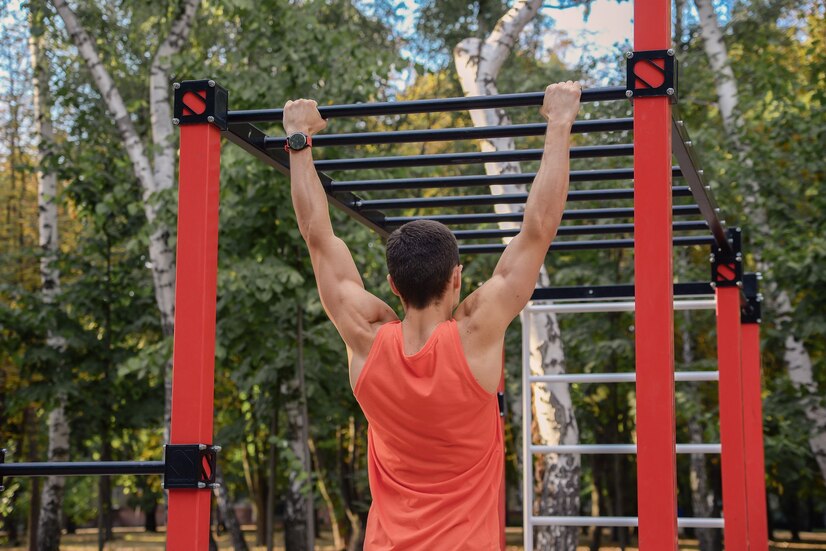Monkey bars, often found on playgrounds, are not just for kids anymore. These simple structures offer a versatile and effective way to improve your fitness level while having fun. In this article, we’ll explore how you can give your fitness routine a makeover by incorporating monkey bars exercises.
Monkey bars are a series of horizontal bars, usually made of metal or wood, positioned at different heights. They are commonly found in playgrounds and outdoor fitness parks. Traditionally used by children for play, monkey bars have gained popularity among adults as a challenging yet enjoyable workout tool.
Benefits of Monkey Bars Workouts
Improves Upper Body Strength
One of the primary benefits of monkey bars workouts is their ability to strengthen the upper body muscles, including the arms, shoulders, and back. Hanging from the bars engages these muscles in a unique way, promoting muscle growth and definition.
Enhances Grip Strength
Maintaining a firm grip on the monkey bars requires significant grip strength. Regular practice can help strengthen the muscles in your hands and forearms, improving your ability to perform daily tasks and other exercises that require grip strength.
Boosts Core Stability
Balancing and stabilizing your body while moving across the monkey bars engages the core muscles, including the abdominals and obliques. This helps improve core stability and control, which is essential for overall strength and balance.
Preparing for a Monkey Bars Workout
Before you start swinging from the monkey bars, it’s important to assess your current fitness level and ensure you have the proper attire and equipment.
Assessing your current fitness level will help you determine which exercises are appropriate for you and set realistic goals for your workouts. Additionally, wearing comfortable clothing and supportive shoes will help prevent injuries and ensure a comfortable workout experience.
Basic Monkey Bars Exercises
Hanging Knee Raises
Hang from the monkey bars with your arms fully extended and your legs dangling below. Slowly raise your knees towards your chest, engaging your abdominal muscles. Lower your legs back down with control and repeat for the desired number of repetitions.
Pull-ups
Grab the monkey bars with an overhand grip, slightly wider than shoulder-width apart. Pull yourself up until your chin clears the bar, then lower yourself back down with control. Repeat for multiple repetitions, focusing on maintaining proper form throughout the exercise.
Leg Raises
Hang from the monkey bars with your arms fully extended and your legs straight. Keeping your core engaged, lift your legs towards the bar until they are parallel to the ground. Lower your legs back down with control and repeat for the desired number of repetitions.
Advanced Monkey Bars Exercises
Muscle-ups
Start by hanging from the monkey bars with an overhand grip. Pull yourself up explosively, using the momentum to transition into a dip position above the bar. Lower yourself back down with control and repeat for multiple repetitions.
L-sit Pull-ups
Grab the monkey bars with an overhand grip and lift your legs up into an L-sit position. Perform a pull-up while keeping your legs elevated, then lower yourself back down with control. This exercise targets the upper body and core muscles simultaneously.
Hanging Windshield Wipers
Hang from the monkey bars with your arms fully extended and your legs straight. Keeping your core engaged, slowly lower your legs to one side, then reverse the movement to the other side. This exercise challenges your core stability and oblique muscles.
Tips for Beginners
- Start with assisted exercises using resistance bands or a spotter to help support your weight.
- Focus on maintaining proper form and technique to prevent injuries and maximize results.
- Gradually increase the intensity of your workouts by adding more repetitions or trying more challenging exercises as you progress.
Common Mistakes to Avoid
- Avoid overgripping the bars, as this can lead to hand fatigue and blisters.
- Minimize swinging or kipping movements, as they can reduce the effectiveness of the exercise and increase the risk of injury.
- Allow for adequate rest and recovery between workouts to prevent overtraining and muscle fatigue.
Monkey Bars Workout Routine
- Warm-up: Perform dynamic stretches and light cardio exercises to prepare your body for the workout.
- Main workout: Perform a variety of monkey bars exercises, focusing on different muscle groups and movement patterns.
- Cool-down and stretching: Finish your workout with static stretches to help relax your muscles and improve flexibility.
Incorporating Monkey Bars into Your Fitness Routine
- Alternate monkey bars exercises with other strength training exercises to prevent overuse injuries and promote overall fitness.
- Set realistic goals for your workouts, such as increasing the number of repetitions or mastering more advanced exercises over time.
- Track your progress by keeping a workout journal or using a fitness app to monitor your performance and stay motivated.
Overcoming Challenges
- Fear of heights: If you’re uncomfortable with heights, start with low monkey bars or practice closer to the ground until you feel more confident.
- Building hand calluses: To prevent blisters and calluses on your hands, gradually increase the intensity of your workouts and allow time for your skin to toughen up.
Monkey Bars for Kids
Monkey bars can also provide valuable exercise opportunities for children, promoting physical fitness and motor skill development. However, it’s essential to ensure their safety by:
- Supervising children during play to prevent accidents or injuries.
- Encouraging proper form and technique to minimize the risk of falls or strains.
Monkey Bars in Public Parks
Many public parks are equipped with monke’y bars and other outdoor fitness equipment, making them accessible and convenient options for outdoor workouts. These parks offer:
- Free access to fitness equipment for people of all ages and fitness levels.
- Opportunities for community engagement and social interaction, as people come together to exercise and enjoy the outdoors.
Conclusion
Monke’y bars offer a fun and challenging way to improve your fitness level and achieve your health and wellness goals. Whether you’re a beginner or an experienced athlete, incorporating monke’y bars exercises into your routine can help you build strength, improve stability, and enhance overall physical fitness.
FAQs
What if I can’t do a single pull-up?
If you’re unable to do a pull-up, start with assisted exercises using resistance bands or a spotter to help support your weight. Gradually build strength and progress to unassisted pull-ups over time.
Is it safe to do monke‘y bars workouts every day?
While monke’y bars workouts can be safe and effective when performed correctly, it’s important to allow for adequate rest and recovery between sessions. Aim for 2-3 sessions per week with rest days in between to prevent overtraining and promote muscle growth.
Can monke‘y bars help with weight loss?
Monke’y bars workouts can contribute to weight loss by increasing calorie expenditure and building lean muscle mass. However, for optimal results, it’s essential to combine regular exercise with a balanced diet and lifestyle habits conducive to weight management.
How do I prevent blisters on my hands?
To prevent blisters and calluses on your hands, gradually increase the intensity of your monke’y bars workouts and allow time for your skin to toughen up. Additionally, consider wearing gloves or using grip aids to protect your hands during exercise.
Are there any age restrictions for using monke‘y bars?
Monke’y bars can be enjoyed by people of all ages, from children to older adults. However, individuals with pre-existing medical conditions or mobility issues should consult with a healthcare professional before starting any new exercise program.







